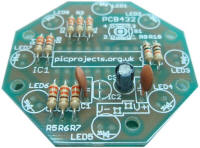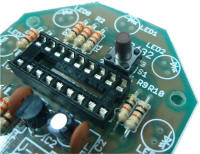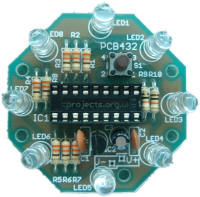|
UFO
round LED Chaser
Kit
for PIC16F628A (#432)
|
 |
Description
This page is has been written
to support construction of the UFO LED Chaser Kit #432K.
This neat little circuit provides 8 LEDs
directly driven from the PIC along with a single mode control switch. The
firmware elsewhere on this page drives the LEDs with a
5 bit PWM signal providing each of the 8 LED channels with four
levels of intensity; off, dim, mid, bright.
A number of sequences are programmed into the firmware to
provide some interesting visual effects and chase sequences.
The software has sequential, random and manual sequence run
modes and manual advance to the next sequence in any mode.
The selected sequence and mode are also saved to non-volatile
memory so it will always restart in the selected mode.
The firmware is the same as that used in the
linear PWM LED chaser
project.
The design is deliberately
simple with each LED being directly driven from a PIC I/O pin.
You can use it with different
sized LEDs and mixed colours, as well as fewer than 8 LEDs.
As well as using it as a LED chaser it is great for adding
effects to toys and models. See FAQ
The firmware pre-programmed
into the PIC16F628A supplied with the kit includes over 34 chase
effects and sequences. If you're interested in PIC
micros and programming and want to modify the sequences or
create new ones, the source code and
programmer ready HEX files is provided at the bottom of this page.
Schematic

Download
schematic in PDF

Circuit Description
The heart of the LED chaser is
the PIC 16F628A microcontroller, IC2. The program that runs on this chip controls the LEDs
attached to the output port pins. Resistors R1 thru R8
limit the current through LED1 - LED8 to a safe level that
won't damage the PICs I/O ports or LEDs. Resistor R9
provides a pull-up for the input connected to switch S1.
R10 holds the PICs MCLR reset signal high.
Capacitor C1 is used to
decouple the 5 volt power supply to the PIC. If you're building the
circuit on a breadboard or stripboard you should ensure it is
located close to the PICs Vdd connection (pin 14 ).
Power is supplied to the
circuit via the V+/V- solder points. The voltage regulator
used is a LM2931-5.0, low-drop-out regulator and will maintain
regulation with an input voltage down to 6 volts. Input
voltage for the LED chaser should be between 6 volts and 14
volts to ensure power dissipation remains within limits.
The LM2931-5.0 regulator is designed for battery powered and
automotive applications and includes internal current limiting,
thermal shutdown, as well as reverse battery connection without damage to
itself or the circuit behind it. Capacitor C3 is important
and must be fitted to prevent instability of the regulator
output
Typical current drawn by the
circuit with all LEDs on is only around 80mA; with all LEDs off
it's under 1mA.
Notes:
- The latest
high brightness LEDs are very bright even with 330R current
limiting resistors. However, if you do need to change these resistors
for some reason take into account the absolute maximum current
that the on-board voltage regulator can deliver is 100mA.
- If you do change the
current limit resistors to suit different LEDs you should
aim for the LED current for each output to be no more than
10mA ( 80mA total for all 8 outputs)
- The 330R resistors are
specified so that with a LED forward voltage of 1.7 volts
and the circuit operating at 5 volts the LED current will be
10mA. LEDs with a higher forward voltage will draw
less current. Most LEDs have a forward voltage greater
than 1.7 volts so the circuit will work with the majority of
LEDs and stay well within the design limits of the circuit.
- The LED forward voltage
parameter for a specific LED will normally be found in the
manufacturers data sheet.
PCB Artwork
and Overlay
Component List
Construction notes:
 Follow these instructions carefully.
Some components need to be fitted the correct way round and
others look similar but have different values so must be fitted
in the correct position.
Follow these instructions carefully.
Some components need to be fitted the correct way round and
others look similar but have different values so must be fitted
in the correct position.
click on the photo's for
large version, click on the back button to return to this page.

Fig.1 |

Fig .2 |

Fig. 3
|
|
In Fig 1.
Start by fitting the two 10K resistors.
 These have
brown-black-orange-gold bands. It doesn't matter
which way round they are fitted. These have
brown-black-orange-gold bands. It doesn't matter
which way round they are fitted.
Fig 2. Next fit
the eight 330R resistors.
 These have Orange-Orange-Brown-Gold
bands. It doesn't matter which way round
they are fitted These have Orange-Orange-Brown-Gold
bands. It doesn't matter which way round
they are fitted
Resistor colour codes explained
Fig 3. Next
fit C1 and C2. These are marked '104' on one side.
|

Fig.4 |

Fig.5 |

Fig.6
|
|
Fig 4. Fit
capacitor C3. This must be fitted the correct way
round. You will see that one lead is shorter than
the other. This short lead should go through the
hole in the PCB indicated in the photo (right)
|
 |
|

Fig 5. Next fit
IC2 (LM2931 LDO voltage regulator). This has three
leads and must be fitted the correct way round.
The body has a 'D' shaped profile when viewed from above
and it should be fitted so it matches the marking on the
PCB overlay
Fig 6. Now fit
the socket for IC1. You will see a small notch in
one end. It should be fitted so the notch is at
the same end as the small semi-circle marking on the PCB
overlay.
|

Fig.7 |

Fig.8 |

Fig.9
|
|
Fig 7. /
8. You now need
to fit the switch S1. This can be fitted to
either the
component side or the
solder side of the PCB. Which side you fit the
switch will depend on how you are going to mount the
assembled board.
 The leads on the switch are a tight fit. Position
the ends of the leads into the holes in the PCB, then
push with even pressure using the tips of your thumbs on
either side of the switch body. It should then snap into
place. Don't try and push it into place using the
button.
The leads on the switch are a tight fit. Position
the ends of the leads into the holes in the PCB, then
push with even pressure using the tips of your thumbs on
either side of the switch body. It should then snap into
place. Don't try and push it into place using the
button.
|
|
Fig 9. You
can now solder the LEDs into position.
 The LEDs must be installed the correct way round.
Each LED has two leads
and one lead will be shorter than the other. The short
lead normally indicates the LED Cathode terminal and
it must be fitted into the hole toward the arrow point
on the PCB overlay (see photo right)
The LEDs must be installed the correct way round.
Each LED has two leads
and one lead will be shorter than the other. The short
lead normally indicates the LED Cathode terminal and
it must be fitted into the hole toward the arrow point
on the PCB overlay (see photo right)
|

Fig.10 |

Fig.11 |

Fig.12
|
|
Fig 10. Solder
the battery connection lead to the solder points as
shown. There is a hole in the PCB and the
leads should be passed through this, then inserted into
the solder points. This provides strain relief for
the wires.
 At this point, if you have access to a voltmeter, apply
power to the board and measure the voltage
between pins
5 and 14 of the IC1 socket. It should measure
somewhere between 4.8 and 5.2 volts. If it doesn't
investigate why and correct the problem before the next
step.
At this point, if you have access to a voltmeter, apply
power to the board and measure the voltage
between pins
5 and 14 of the IC1 socket. It should measure
somewhere between 4.8 and 5.2 volts. If it doesn't
investigate why and correct the problem before the next
step.
Fig
11. Finally you can fit IC1, the PIC 16F628A
microcontroller. The PIC has a notch in one end of
the device and assuming you have fitted the socket
correctly, the PIC should be inserted into the socket
with the notch in the PIC at the same end.
Referring back to Fig 10. the notch should be at the
right hand end as seen in the photo.
With all parts assembled, check the underside of the
board to make sure the solder joints are good and there
are not shorts or solder bridges. If the
inspection is okay, you can now connect the assembled
board to a battery or power supply.
The input voltage to
the board should be between 6 volts and 14 volts.
Fig 12. This
photo show the completed LED chaser operating. The LEDs
have been bent at a right angle to change the visual
effect of the chaser. |
 All #432K kits sold after 20 August 2011 will include a
DPDT slide switch to enable the circuit to be switched
on and off without disconnecting the battery clip.
All #432K kits sold after 20 August 2011 will include a
DPDT slide switch to enable the circuit to be switched
on and off without disconnecting the battery clip.
To fit the switch, cut
one of the battery lead wires about half way along
its length. Then solder the cut ends of the leads to
the centre and one edge terminal on the switch as show
in the photo below.
Supplied switch has two x
M2 fixing holes on 19mm centres.
|
 |
 |
Power Supply
The board can be powered from a
9 volt battery such as a PP3, or a 12 volt battery including
connection to a car electrical system. Alternatively it
can be connected to a suitable DC power supply rated between 6
and 14 volts and able to supply at least 100mA.
In the UK you can buy a suitable power
adapter from Rapid Electronics. You'll also find similar
power adapters available from retail stores and e-Bay.
Rapid
Electronics 5W SWITCH MODE PLUGTOP PSU 9V 550MA
RC Part # 85-2926
User Operation Guide
The program has three modes of
operation.
- Manual mode will run the
same sequence continually. When the switch is pressed it
will skip to the next sequence in program memory.
- In auto-sequential mode,
the program runs through each sequence in program memory
until it reaches the end of all defined sequences at which
point it restarts from the first one.
- In random mode the program
selects sequences randomly.
When the code is running in any
mode, a short press of the switch will make the controller skip
to the next sequence.
To enter setup mode, press and
hold the switch. Once it enters setup mode one of three
LEDs will light indicating the current run mode. A short
press of the switch cycles through the three modes. When the
desired run mode has been selected, press and hold the switch to
exit setup and return to run mode.

The current mode and selected
sequence are automatically saved to the PICs internal
non-volatile EEPROM memory 10 seconds after the last switch
press. When the LED chaser is next powered up it will load
and start running using the saved mode and sequence.
Description of Sequence Data
| The data
used to create the sequences is held in a separate
include file. You can add, remove or edit this
data to create your own chaser sequences.
To make the creation of
the data file easier a set of macros have been defined
which are used to create the sequence data. This
is described in the
Sequence data flowchart
 (also available
as a JPEG image right)
(also available
as a JPEG image right)
If you download the
source code and look at the file named
pwmc_SeqData.inc you can see the data used in the
project. You might want to edit this file as a
starting point to create some sequences of your own.
Notes:
- In manual mode,
when the repeat count reaches zero it will restart
the same sequence, to advance to the next sequence
press the switch.
- In Random mode it
will select a random sequence number to run. If
the Mirror flag is true for that sequence it will
also randomly choose to mirror the data or not.
- In auto-sequential
mode if the Mirror flag is true it will run the
sequence and then repeat it with the data mirrored.
|
 |
Firmware
The PIC supplied in the kit is
pre-programmed with the firmware
below so you don't need to do anything.
Should you need to reprogram the
supplied PIC with the original code supplied, use the HEX file below.
The HEX files are ready to
program straight into the respective PIC chip. The latest
code version 1.0.7 supports the PIC 16F628/628A and PIC 16F88
microcontrollers.
The Source code will allow you
to create your own sequences and then reassemble the code to use
them with the UFO LED Chaser kit.
Quick guide to
reassembling firmware using MPLAB
If you need a PIC Programmer I
strongly recommend the
Microchip PICKit 2,
this is available from suppliers world wide or direct from
Microchip. It's reasonably cheap to buy and reliable.
Not got a programmer? Buy
a pre-programmed PIC from the On-line store
|
Description |
Filename |
Download link |
| |
|
|
| Source
code for 16F628A/88 |
pwmchaser107.zip
V1.0.7 03/04/2009 |
 download
download |
HEX file
ready to program into the PIC.
Use with 16F628 / 16F628A only |
pwmc_main107_ufo.HEX
V1.0.7 03/04/2009 |
 download
download
checksum D9A8 |
| |
|
|
| |
|
|
FAQ
Can you or
how can I make it it run
more than 8 LEDs?
This is probably the most
frequent of the frequently asked questions :-)
The project is an 8 LED Chaser
and the firmware was written to work as an 8 LED chaser.
There is no quick and easy
change to make it a 9, 12 or some other number of LED chaser.
If you need a chaser with more LEDs then this project is not
suitable for your needs.
Will it work
with 3mm LEDs?
Yes, 3mm LEDs will work as will
8mm and 10mm LEDs. 3mm LEDs can be mounted on the PCB, 8mm
and 10mm LEDs would need to be connected by flying leads.
Can I use
less than 8 LEDs?
Yes, since the sequences are
user definable you can create sequences that use less than 8
LEDs.
I only want
it to run one sequence, can it do that?
Since the current mode and
selected sequence are saved to NVRAM, it always powers up in the
last mode and running the last sequence. Therefore if you
select manual mode and the sequence required, it will run only
that sequence until you change it.
Do the LEDs
have to be the same colour?
No they don't. If you
want you can mix different coloured LEDs. You can also mix
3mm/5mm/8mm/10mm LEDs if you want too.
Can you add
a button or potentiometer to change the speed?
The sequences don't have a
speed as such, the data for each step in a sequences includes a
hold time which has to elapse before moving to the next step in
the sequence. This hold time is user defined and can be
different for each step in a sequence. The speed a
sequence runs at is therefore fixed in the data and there is no
option to speed up or slow down a sequence when it is running.
See Description of
Sequence Data
Can it run
from a 12volt car battery?
Yes, should work fine from a
car battery. We suggest you include an in-line fuse of
500mA in series with the power lead to the board.
Can you
modify the code to run on a PIC type xyz?
The code has been written to
run on three of the most popular PICs available. If you
want to modify the source code it could be made to run on other
PIC types, however we won't modify the code.
|